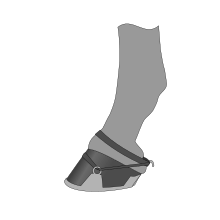Hipposandal


The Hipposandal (Latin soleae ferreae)[1] is a device that protected the hoof of a horse. It was commonplace in the northwestern countries of the Roman Empire,[1][2][3] and was a predecessor to the horseshoe.
The necessity of protecting the horse hoof was recognised by the ancient Greeks and Romans, and written about by Xenophon.[4] An early form of hoof protection was seen in ancient Asia, where horses' hooves were wrapped in rawhide, leather or other materials for both therapeutic purposes and protection from wear.[5] Elsewhere, various methods were employed to trim the hoof into a hollow form and give it as much hardness as possible. Gradually, protection items started to appear, first with the soleae Sparteae, a sort of leather hoof boot, later improved into the soleae ferreae that featured metal studded soles similar to contemporary military boots.[4]
The hipposandal, which appears in the Celtic-Roman area north of the Alps around the mid-1st century AD,[1] was the next step in the development of hoof protection, where the sole of the boot was made of metal. It included an oval-shaped cup of thick metal that enclosed and protected the hoof, complete with a fixation system. The device was fastened to the hoof by metallic clips and leather laces. Like the Soleae Sparteae and soleae ferreae, the hipposandal increased ground adherence of draught animals,[6] thereby giving them better traction,[4] and protected the hoof on rough ground. To further improve traction, the bottom of each hipposandal was grooved.
There is speculation that the Gauls were the first to nail on metal horseshoes.[7] The nailed iron horseshoe first clearly appeared in the archaeological record in Europe in about the 5th century AD when a horseshoe, complete with nails, was found in the tomb of the Frankish King Childeric I at Tournai, Belgium.[8] In Gallo-Roman countries, the hipposandal appears to have briefly co-existed with the nailed horseshoe.[1][6]
In 2006, Channel Four's history programme Time Team featured an episode where hipposandals were recreated and tested; however, they were reported to have been uncomfortable and unsuitable for long journeys.[9]
References
| Wikimedia Commons has media related to Hipposandals. |
- 1 2 3 4 2000 Years of Shoeing?, by Dr. Hiltrud Strasser
- ↑ Ancient Battlefield Hints at Roman Persistence, by Andrew Curry
- ↑ Recent Light on the Roman Horseshoe, The Classical Journal Vol. 29, No. 9 (June 1934)
- 1 2 3 The History of Farriery, Irish Farriery Authority
- ↑ Cohen, Rachel. "The History of Horseshoes." EquiSearch. Web. 11 Nov. 2009.
- 1 2 British Museum
- ↑ McBane, Susan A Natural Approach to Horse Management London:Methuen 1992 ISBN 0-413-62370-X p. 57–60
- ↑ "Horseshoe." Encyclopædia Britannica. 15th ed. Vol. 20. 2005. 651-51. Print.
- ↑ Horseshoes in Roman and Post-Roman use, Carla Nayland
Further reading
- Birds and beasts in Roman Britain, British Museum
- Hippo Sandal. Roman period. Wroxeter. Shrewsbury Museums Service.